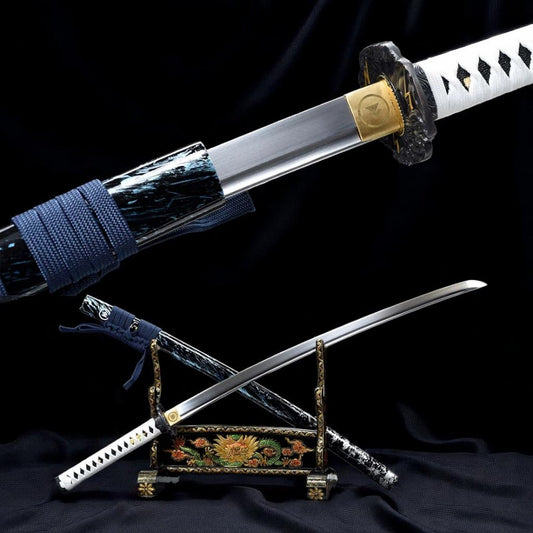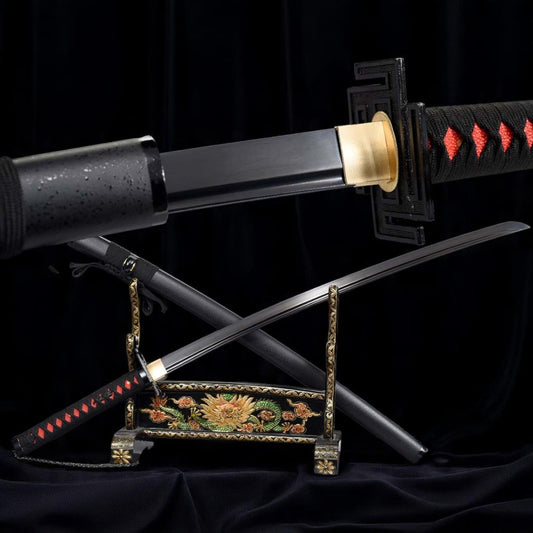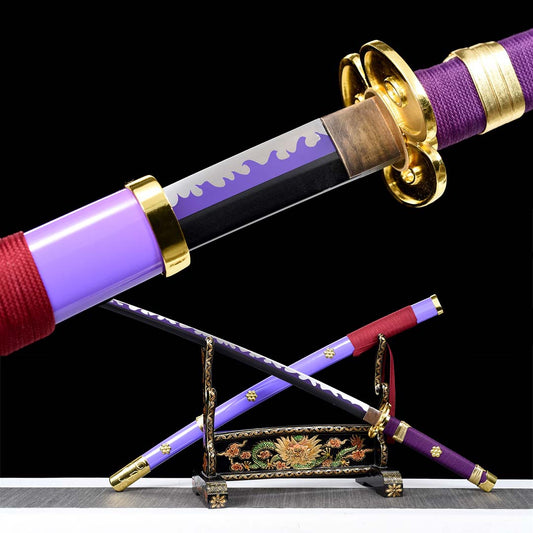
Anatomy of a Katana – All the Parts Explained (Plus Blade Steel Types)
Share
Introduction
Whether you're buying your first katana or customizing your own, understanding the anatomy of a katana is essential. From the razor-sharp blade to the hand-wrapped handle, each component plays a crucial role in the sword's performance, balance, and beauty.
This comprehensive guide breaks down every component of a katana — and at the end, we'll explain the most common types of steel (1060, T10, Damascus, and more) to help you make the right choice for 2025.
Main Parts of a Katana

1. Blade (Ha)
The heart of the katana. It's a curved, single-edged steel blade designed for both cutting and slicing. A well-forged blade displays a visible hamon — a wavy line that reflects the differential tempering process and indicates quality craftsmanship.
2. Spine (Mune)
The back of the blade, opposite the cutting edge. This unsharpened section helps balance the blade's flexibility and strength, contributing to the katana's overall structural integrity.
3. Tip (Kissaki)
The pointed end of the blade, primarily used for thrusting attacks. A properly shaped kissaki is a hallmark of a high-quality katana and requires skilled craftsmanship to achieve.
4. Guard (Tsuba)
Located between the blade and the handle, the tsuba protects your hand from sliding onto the blade and helps balance the sword. Some tsubas feature minimalist designs, while others are ornate works of art that reflect traditional Japanese aesthetics.
5. Habaki (Blade Collar)
A small metal wedge that securely locks the blade inside the saya (scabbard) and ensures a tight, rattle-free fit. It also helps transfer force efficiently between the blade and handle during use.
6. Handle (Tsuka)
The grip section, traditionally wrapped in cotton or silk cord over rayskin (samegawa) for enhanced grip. It's built around a full tang construction and secured with bamboo pegs (mekugi) for maximum stability and safety.
7. Mekugi (Bamboo Pegs)
These essential components hold the handle firmly to the blade tang. Most quality katanas use one or two mekugi for optimal safety and structural integrity.
8. Pommel (Kashira)
The end cap of the tsuka, often matched in style and material with the tsuba. It provides essential counterweight to balance the blade and serves as an aesthetic finishing touch.
9. Saya (Scabbard)
The protective wooden sheath that houses the blade when not in use. Traditionally lacquered and fitted with cord wrapping (sageo) for secure display or wearing at the side.
Bonus: Blade Steel Types Explained (Updated for 2025)

⚔️ 1060 Carbon Steel
This remains one of the most popular and reliable steels for functional katanas in 2025. It offers an excellent balance between flexibility and cutting power — perfect for beginners or regular practice. The steel is easy to maintain and provides consistent performance. See a 1060 carbon steel katana
⚔️ 9260 Spring Steel
Renowned for exceptional elasticity and resistance to bending, 9260 katanas are ideal for intensive use or tameshigiri (cutting practice). While less traditional than carbon steel, it offers superior durability for modern practitioners in 2025.
⚔️ T10 Tool Steel
A premium steel choice known for outstanding edge retention and hardness. T10 katanas are truly battle-ready and often display dramatic, pronounced hamon lines. This steel type has gained significant popularity among serious collectors throughout 2025. See a T10 steel katana
⚔️ Damascus Steel
Not a specific steel type, but rather a sophisticated forging technique. Damascus blades are layered and folded multiple times to create distinctive wavy patterns. These blades perfectly combine performance with stunning visual appeal, making them highly sought after by collectors who appreciate both function and artistry. See a Damascus katana
Conclusion
Understanding the anatomy of a katana deepens your appreciation for both its functional design and exceptional craftsmanship. Whether you're customizing your own sword or selecting a ready-made model, knowing the role of each component will empower you to make well-informed decisions that match your needs and preferences in 2025.
Ready to design your own blade? Try our Katana Customizer or browse the full Katana Collection to explore all available materials and styles for 2025.




